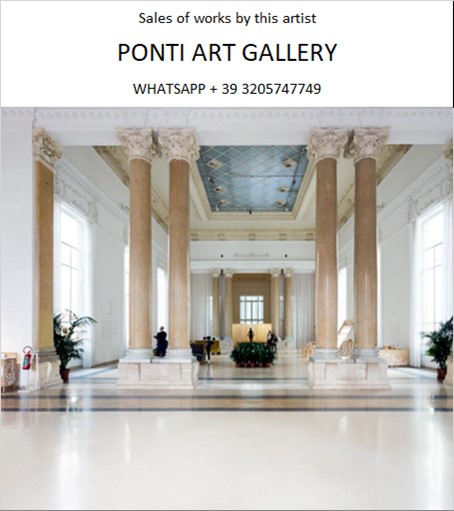Ponti Art Gallery is interested in buying and selling works
of art by this artist.

John-Henry Twatchman Biography
John Henry Twachtman, an American painter renowned for his impressionist landscapes, was born on August 4, 1853, in Cincinnati, Ohio. His parents, Frederick Christian Twachtman and Sophia Droege Twachtman, were German immigrants. Twachtman's early life in Cincinnati was marked by his family's modest means, which led him to work as a window shade decorator alongside his father from the age of fourteen. Despite these early responsibilities, he pursued his passion for art by attending classes at the Ohio Mechanics Institute.
Twachtman's artistic journey took a significant turn when he enrolled part-time at the McMicken School of Design, now known as the Art Academy of Cincinnati. It was here that he met Frank Duveneck, an artist only five years his senior but already enjoying success in the United States. Duveneck, recognizing Twachtman's talent, invited him to share his studio and eventually to study in Europe.
In 1875, Twachtman began his studies under Ludwig von Loefftz at the Royal Academy of Fine Arts in Munich, where he adopted the school's characteristic broad brushwork and somber tones. His palette remained relatively unchanged even after a trip to Venice in 1877 with Duveneck and William Merritt Chase. Upon returning to the United States in 1878, Twachtman briefly taught at the Women's Art Association of Cincinnati before moving east and joining the Society of American Artists in 1879.
Twachtman's European sojourn continued in 1880 when he returned to assist Duveneck in Florence. In 1881, he married Martha Scudder in Cincinnati, and the couple traveled abroad, staying until just before the birth of their first child in 1882. During this period, Twachtman spent time in Holland, painting and etching with his close friend Julian Alden Weir.
From 1883 to 1885, Twachtman studied at the Academie Julian in Paris, where his style underwent a significant transformation. His brushwork became more subdued, and his palette lightened, possibly influenced by the French painter Jules Bastien-Lepage and the expatriate James McNeill Whistler. By 1886, Twachtman and his family had returned to the United States, settling in New York. To support his family, he painted Civil War battle scenes on a cyclorama in Chicago during the winter of 1886-1887.
Twachtman's career as an educator began in 1889 when he started teaching at the Art Students League in New York and produced illustrations for Scribner's Magazine. Around this time, he purchased a farm in Greenwich, Connecticut, which inspired many of his best-known landscapes. His work from the 1890s, known as his "Greenwich period," was characterized by rough and layered brushwork.
In 1893, Twachtman's work was included in an exhibition alongside J. Alden Weir, Claude Monet, and Paul-Albert Besnard, and he won a medal at the World's Columbian Exposition in Chicago. A year later, he received commissions for a landscape series of Niagara Falls and Yellowstone National Park. In 1897, he became a founding member of The Ten, a group of artists who exhibited together until his death in 1902.
Twachtman's final summer was spent painting in Gloucester, Massachusetts. His artwork combined the techniques of Impressionism and Tonalism, creating landscapes noted for their muted earth tones and ability to convey the emotion and beauty of nature. His subjects were often simple scenes—a farm pasture, an old house, a stretch of ocean—and he was also known for his winter landscapes.
Art historians consider Twachtman's style of impressionism to be among the more personal and experimental of his generation. He was a member of "The Ten," a loosely-allied group of American artists dissatisfied with professional art organizations, who banded together in 1898 to exhibit their works as a stylistically unified group.
Twachtman's influence extended beyond his paintings. As an instructor, he encouraged his students to develop their own ways of seeing and to distill the essential, omitting distracting details. He taught at various institutions, including Cooper Union and the Art Students League of New York, where he provided consistent employment until his untimely death on August 8, 1902, in Gloucester, Massachusetts, at the age of 49.
Twachtman's legacy is preserved through his artworks and the impact he had on American Impressionism. His paintings continue to be celebrated for their originality and the unique vision he brought to the American art scene.
John-Henry Twatchman Quotes
and Sales of Works
Ponti Art Gallery selects and deals with paintings by the
artist. Upon request, we provide free estimates and
evaluations, communicate prices, quotations, and current
market values.
If you are interested in BUYING or SELLING works by the
artist, contact us immediately.
If you wish to sell or receive an evaluation of the
works:
Send us a frontal photo of the painting, one of the back,
and one of the signature. Also, indicate the dimensions of
the work. Inform us about the purchase origin of the work
and any kind of available documentation (purchase
receipts, certificates of authenticity, publications). One
of our operators will respond to you on the same day. We
guarantee maximum confidentiality and extreme
professionalism.
If you wish to purchase works by the painter: Contact us
and let us know your request. We will inform you about the
available works. We also offer the possibility to
subscribe to our NEWSLETTER, through which you will be
informed at the beginning of each month about the latest
acquisitions of the art gallery.
You can send us pictures of the work:
